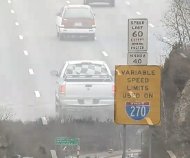Missouri Expands Unpopular Freeway Variable Speed Trap System
The Missouri Department of Transportation (MoDOT) announced Wednesday that it was expanding a system for lowering speed limits on the freeway, despite its own surveys showing the public has a “high level of dissatisfaction with the system.” A study conducted on behalf of MoDOT by the Missouri University of Science and Technology included a few positive statistics about the performance of Variable Speed Limits, but the overall conclusion was that the program failed to provide the promised benefits.
In May 2008, MoDOT installed a Variable Speed Limit system on sections of Interstate 270 and Interstate 255 in St. Louis. Using electronic signs, MoDOT officials lowered the speed limit from 60 MPH to as little as 40 MPH throughout the day in response to changing conditions. The goal was to make traffic speeds more consistent to reduce congestion. In practice, however, the system frequently displayed a low speed limit when the road was clear and the 60 MPH limit in bumper-to-bumper traffic. Big rig trucks driving in the right-hand lane frequently blocked the view of the lowered limit sign, setting up motorists for hefty speeding tickets for driving as much as 20 MPH without their knowledge.
As a result, 79 percent of the public believed the program did nothing to reduce travel times. A full 65 percent want the program eliminated, and 71 percent think the speed limit should be raised to 70 MPH. Police officers in the area were equally unenthusiastic about the project.
“Over three hundred law enforcement officials completed paper surveys,” the study reported. “Law enforcement officers also reported negative responses to the VSL. They do not believe that it has reduced the number of crashes, alleviated stop and go traffic, or reduced congestion. Moreover, they overwhelmingly believe that it has been ineffective in increasing driver compliance with posted speed limits. The vast majority report that it should be eliminated and not considered for expansion.”
MoDOT touted the slight reduction in travel times found in three of the four segments analyzed to declare the program a success. It also cited accident reductions on Interstate 270, even though 69 percent of police officers surveyed thought the program did nothing to improve safety. Beginning in July, MoDOT will use the electronic signs to lower the speed limit down to 10 MPH. The new signs will be “advisory only,” meaning police will not issue citations to anyone driving under 60 MPH.
A copy of the study is available in a 1.6mb PDF file at the source link below.
Evaluation of Variable Speed Limits on I-270/I-255 (Missouri Department of Transportation, 10/10/2010)
[Courtesy: Thenewspaper.com]
More by The Newspaper
Latest Car Reviews
Read moreLatest Product Reviews
Read moreRecent Comments
- ToolGuy First picture: I realize that opinions vary on the height of modern trucks, but that entry door on the building is 80 inches tall and hits just below the headlights. Does anyone really believe this is reasonable?Second picture: I do not believe that is a good parking spot to be able to access the bed storage. More specifically, how do you plan to unload topsoil with the truck parked like that? Maybe you kids are taller than me.
- ToolGuy The other day I attempted to check the engine oil in one of my old embarrassing vehicles and I guess the red shop towel I used wasn't genuine Snap-on (lots of counterfeits floating around) plus my driveway isn't completely level and long story short, the engine seized 3 minutes later.No more used cars for me, and nothing but dealer service from here on in (the journalists were right).
- Doughboy Wow, Merc knocks it out of the park with their naming convention… again. /s
- Doughboy I’ve seen car bras before, but never car beards. ZZ Top would be proud.
- Bkojote Allright, actual person who knows trucks here, the article gets it a bit wrong.First off, the Maverick is not at all comparable to a Tacoma just because they're both Hybrids. Or lemme be blunt, the butch-est non-hybrid Maverick Tremor is suitable for 2/10 difficulty trails, a Trailhunter is for about 5/10 or maybe 6/10, just about the upper end of any stock vehicle you're buying from the factory. Aside from a Sasquatch Bronco or Rubicon Jeep Wrangler you're looking at something you're towing back if you want more capability (or perhaps something you /wish/ you were towing back.)Now, where the real world difference should play out is on the trail, where a lot of low speed crawling usually saps efficiency, especially when loaded to the gills. Real world MPG from a 4Runner is about 12-13mpg, So if this loaded-with-overlander-catalog Trailhunter is still pulling in the 20's - or even 18-19, that's a massive improvement.


































Comments
Join the conversation
"As a result, 79 percent of the public believed the program did nothing to reduce travel times. A full 65 percent want the program eliminated, and 71 percent think the speed limit should be raised to 70 MPH. Police officers in the area were equally unenthusiastic about the project." In other words, anecdotal evidence and opinion-based (not fact-based) surveys give the system a bad score. But: "MoDOT touted the slight reduction in travel times found in three of the four segments analyzed to declare the program a success. It also cited accident reductions on Interstate 270, even though 69 percent of police officers surveyed thought the program did nothing to improve safety." Let's rewrite this paragraph to take out the pejorative adjectives and weasel words: MoDOT's analysis showed reduction in travel times on three of the four segments analyzed, and accident reductions on Interstate 270. Many police officers disagreed, but had no evidence beyond their feelings. Looks a little different after the linguistic bias-ectomy. Maybe variable speed limits work and maybe they don't, but you can't tell from this I'm-gonna-grind-this-ax-no-matter-what article.